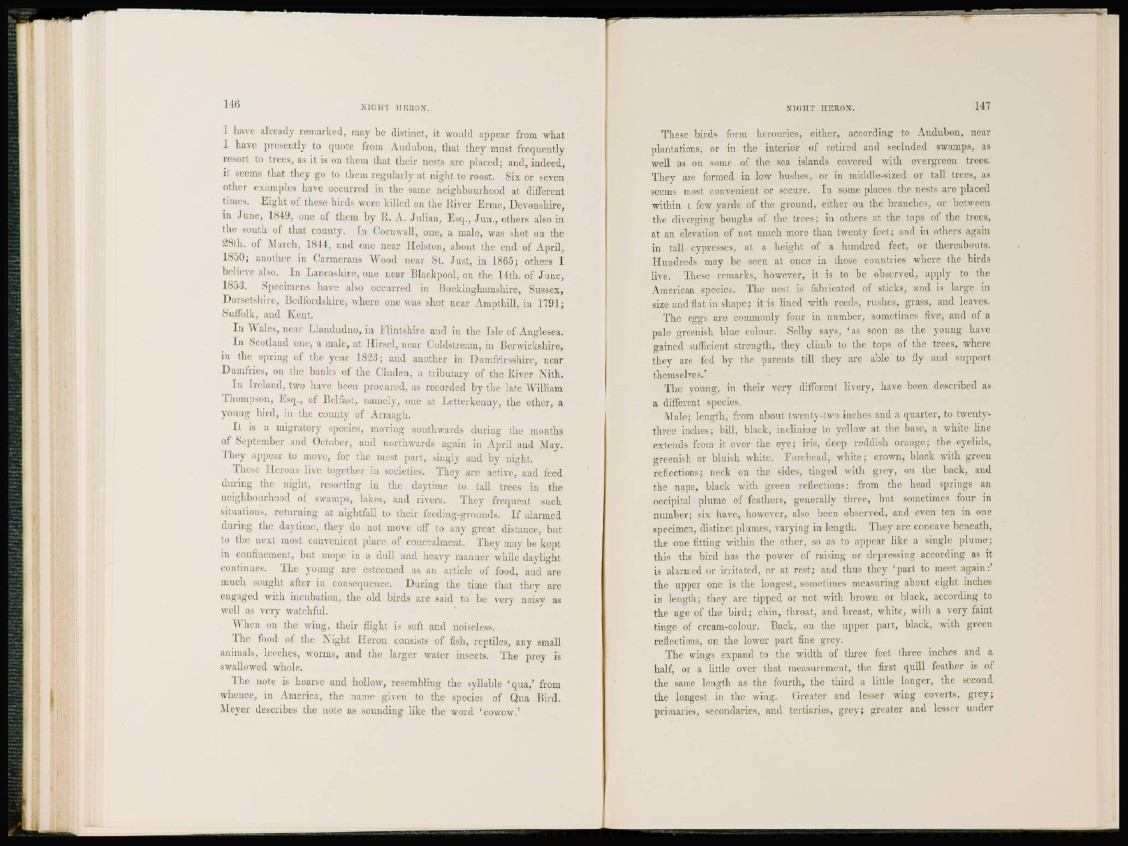
NIGHT HERON.
1 hare already remarked, may be distinct, it would appear from what
I have presently to quote from Audubon, that they must frequently
resort to trees, as it is on them that their nests arc placed; and, indeed,
it seems that they go to them regularly at night to roost. Six or seven
other examples have occurred in the same neighbourhood at different
times. Eight of these birds were killed on the River Erme, Devonshire,
in June. 1st!), one el' them by K. A. Julian, Esq., Jim., others also in
the south of that county. In Cornwall, one, a male, was shot on the
28th. of March, 1844, and one near Helston, about the end of April,
1850; another in Carmerans Wood near St. Just, in 1865; others I
believe also. In Lancashire, one near Blackpool, on the 14th. of June,
1853. Specimens have also occurred in Buckinghamshire, Sussex,
Dorsetshire, Bedfordshire, w*hcre one was shot near Ampthill, in 1791;
Suffolk, and Kent.
I n Wales, near Llandudno, in Flintshire and iu the Isle of Anglesea.
In Scotland one. a male, at Hirsel, near Coldstream, iu Berwickshire,
iti the spring of the year 1823; and another in Dumfriesshire, near
Dumfries, on the banks of the Linden, a tributary of the River Nith.
I n Ireland, two have been procured, as recorded by the late William
Thompson, Esq., of Belfast, namely, one at Letterkenuy, the other, a
young bird, in the county of Armagh.
I t is a migratory species, moving southwards during the months
of September and October, and northwards again in April and May.
They appear to move, for the most part, singly and by night.
These Herons live together iu societies. They are active, and feed
during the night, resorting in the daytime to tall trees in the
neighbourhood of swamps, lakes, ami rivers. They frequent such
situations, returning at nightfall to their feeding-grounds. If alarmed
during the daytime, they do not move off to any great distance, but
to the next most convenient place of concealment. They may be kept
in confinement, but mope in a dull and heavy manner while daylight
continues. The young are esteemed as an article of food, and are
much sought after in consequence. During the time that they are
engaged with incubation, the old birds arc said to be very noisy as
well as very watchful.
When on the wing, their f l i g h t is soft and noiseless.
The food of the Night Heron consists of fish, reptiles, any small
animals, leeches, worms, and the larger water insects. The prey is
swallowed whole.
The note is hoarse and hollow, resembling the syllable 'qua,' from
whence, in America, the name given to the species of Qua Bird.
Meyer describes the note as sounding like the word 'cowow.'
NTGIIT IIER-ON. 117
These birds form heronries, either, according to Audubon, near
plantations, or in the interior of retired and secluded swamps, as
well as on some of the sea islands covered with evergreen trees.
They are formed in low bushes, or in middle-sized or tall trees, as
seems most convenient or secure. In some places the nests are placed
within a lew yards of the ground, either on the branches, or between
the diverging boughs of the trees; in others at the tops of the trees,
at an elevation of not much more than twenty feet; and in others again
in tall cypresses, at a height of a hundred feet, or thereabouts.
Hundreds may he seen at once in those countries where the birds
live. These remarks, however, it is to be observed, apply to the
American species. The nest is fabricated of sticks, and is large in
size and flat in shape; it is lined with reeds, rushes, grass, and leaves.
The eggs are commonly four in number, sometimes five, and of a
pale greonidi blue colour. Selby says, 'as soon as the young have
gained sufficient strength, they climb to the tops of the trees, where
they are fed by the parents till they are able to fly and support
themselves.'
The young, in their very different liverv, have been described as
a different species.
Male; length, from about twenty-two inches and a quarter, to twentvthree
inches; bill, black, inclining to yellow at the base, a white line
extends from it over the eye; iris, deep reddish orange; the eyelids,
greenish or bluish white. Forehead, white; crown, black with green
reflections; neck on the sides, tinged with grey, on the back, and
the nape, black with green reflections; from the head springs an
occipital plume of feathers, generally three, but sometimes four in
number; six have, however, also been observed, and even ten in one
specimen, distinct plumes, varying in length. They are concave beneath,
the one fitting within the other, so as to appear like a single plume;
this the bird has the power of raising or depressing according as it
is alarmed or irritated, or at rest; and thus they ' p a r t to meet again:'
the upper one is the longest, sometimes measuring about eight inches
in length; they are tipped or not with brown or black, according to
the age of the bird; chin, throat, and breast, white, with a very faint
tinge of cream-colour. Back, on the upper part, black, with green
reflections, on the lower part fine grey.
The wings expand to the width of three feet three inches and a
half, or a little over that measurement, the first quill feather is of
the same length as the fourth, the third a little longer, the second
the longest in the wing. Greater and lesser wing coverts, grey;
primaries, secondaries, and tertiaries, grey; greater and lesser under